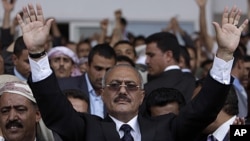Yemen's president, wounded Friday in a rocket attack on his compound, has survived three decades of challenges.
President Ali Abdullah Saleh has ruled Yemen since the country's unification in 1990. He had served as leader of North Yemen since 1978 and played a key role in the merger between the North and the communist South.
Saleh is one of Yemen's longest-serving leaders. He was re-elected to a seven-year term in 2006. Saleh has said he will not seek re-election in 2013, but will not meet international and opposition demands that he leave office immediately.
Saleh has been challenged by al-Qaida militants, Shi'ite Zaidi rebels and anti-government protesters.
Saleh started his career in Yemen's military, where he rose through the ranks. He fought in a civil war that began in 1962.
Saleh is from a tribal branch that is part of the al-Ahmar family. However, tribal chief Sadiq al-Ahmar emerged as one of his most prominent challengers after anti-government unrest erupted in January.
Opponents have been demanding his immediate resignation.
In April, the six-nation Gulf Cooperation Council presented Saleh with a plan designed to end Yemen's unrest by providing for a timetable for Saleh to leave office and paving the way for new elections.
Saleh has declined to sign the agreement, even after several attempts by Gulf leaders to broker an end to the crisis.
Some information for this report was provided by AP, AFP and Reuters.







